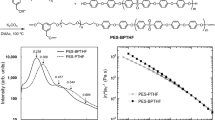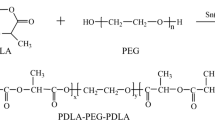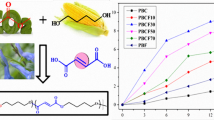Abstract
ABA-type triblock copolymers (PEOxz-PTHF-PEOxz) composed of poly(tetrahydrofuran) (PTHF) and poly(2-ethyl-2-oxazoline) (PEOxz) were synthesized by cationic sequential polymerization. Differential scanning calorimetry and wide-angle X-ray diffraction analyses revealed that PEOxz-PTHF-PEOxzs produced a microphase separation structure, which consisted of a partially crystallized amorphous PTHF phase containing PEOxz chains on both ends. Tensile testing showed that PEOxz-PTHF-PEOxz exhibited tough mechanical properties that differed from those of the brittle PTHF homopolymer. Thus, it was suggested that the amorphous PTHF/PEOxz phase played a role in physically cross-linking the moieties via entanglement, resulting in a PEOxz-PTHF-PEOxz material with tough mechanical properties and the ability to be cold-drawn.
Similar content being viewed by others
Introduction
It is well known that block copolymers sometimes exhibit characteristic properties that arise from microphase separation and that are quite different from the characteristic properties of random copolymers or polymer blends. Styrene-butadiene rubber is a typical block copolymer. The origin of the elastic property of styrene-butadiene rubber is associated with the formation of a microphase-separated structure comprising polystyrene domains and a butadiene matrix.1, 2
Poly(tetrahydrofuran)s (PTHFs) are commonly used as a soft segment in polyurethanes and polyesters.3 Polyurethanes have been widely applied to coatings, adhesives, foams, fibers, elastomers and so on. Polyurethane elastomers (PUEs) are generally synthesized from diisocyanate, polymer glycol and a chain extender. The PUEs consist of a hard segment formed from diisocyanate and a chain extender and a soft segment formed from polymer glycol. The hard segments act as the physical cross-linking point of PUEs. The PTHF-based PUEs usually show excellent mechanical properties and a high resistance to hydrolysis. Yang et al. synthesized poly(lactic acid)-PTHF-poly(lactic acid) triblock copolymers and studied the effects of hydrophobic PTHF on the enzymatic degradability.4 They found that the enzymatic degradation rate decreased as the content of PTHF increased, and the hydrophobicity promoted enzymatic antidegradation of poly(lactic acid). In contrast, poly(oxazoline) has imino acyl groups in the main chain, a strong polarity and amorphous properties5 and is utilized in biocompatible materials. Because oxazoline can be polymerized with an active halogen atom or active cationic species, the well-defined block copolymer poly(oxazoline)-PTHF can be synthesized by sequential polymerization with THF. Block-copolymers of PTHF and poly(oxazoline)s are nontoxic and environmentally compatible and exhibit low glass-transition temperatures and low-surface tension values. Therefore, these copolymers have been applied to surfactants, lubricants, water repellents and antifoaming agents. Caeter et al.6 synthesized an ABA-type triblock copolymer that consisted of 10 k–19 k number-average molecular weight (Mn) PTHF at the center and 1.5 k Mn poly(2-methyl-2-oxazoline) (PMeOxz) at both ends. They identified shape memory effects and attributed them to the phase separation between the two blocks and the strong polar interaction between PMeOxz segments.
In this study, we synthesized ABA triblock-copolymers composed of poly(2-ethyl-2-oxazoline) (PEOxz) blocks and PTHFs block by sequential living ring-opening copolymerization and investigated the relation between phase structure and the mechanical properties of the copolymer. We used PTHF with a degree of polymerization (DP) of 300, which was expected to be enough for crystallization of the PTHF block. Then, the DP of the PEOxz blocks were tuned to 4 and 9 to investigate how the end PEOxz blocks affected the aggregation structure and crystallization of PTHF.
Experimental Procedure
Materials
Trifluoromethanesulfonic anhydride (Tf2O, Sigma-Aldrich Chemicals, Tokyo, Japan) was used as received. Acetonitrile (CH3CN, Sigma-Aldrich Chemicals), 2-ethyl-2-oxazoline (EOxz, Sigma-Aldrich Chemicals), di-n-butylamine (WAKO Chemicals Co., Ltd., Tokyo, Japan) and tetrahydrofuran (THF, WAKO Chemicals Co., Ltd.) were used after distillation over calcium hydride (WAKO Chemicals Co., Ltd.).
Synthesis of PTHF
Polymerization of 44.5 g (617.50 mmol) of THF was carried out by stirring at 25 °C for 45 min with 0.25 g (0.87 mmol) of Tf2O as a bifunctional initiator. The oxonium-ended PTHF prepolymer was terminated with 0.59 g (4.59 mmol) of di-n-butylamine. Precipitation with hexane and filtration yielded 43.7 g of PTHF.
Synthesis of PEOxz-PTHF-PEOxz
To the active PTHF, prepared from 9.88 g (136.8 mmol) of THF and 0.03 g (0.12 mmol) of Tf2O as described above, 0.02 g (0.24 mmol) of EOxz was added. After evaporation of residual THF under vacuum, 20 ml of CH3CN and 0.23 g (2.32 mmol) of EOxz were added to the mixture, followed by stirred at 60 °C for 20 h. The initial ratio of EOxz to Tf2O was changed to prepare block copolymers with various PEOxz block lengths. The termination of polymerization by the addition of 0.19 g (1.46 mmol) di-n-butylamine and precipitation from chloroform solution with hexane gave 9.62 g of block copolymer, PEOxz4-PTHF300-PEOxz4. Here, the copolymer is presented by the abbreviation PEOxz9-PTHF300-PEOxz9, in which the number is designative of the polymerization degree. It was impossible to synthesize copolymers with PEOxz blocks larger than DP 9.
Characterization
The chemical structures, polymerization degree of each block and number-average molecular weight (Mn) of PTHF300 and PEOxz-PTHF-PEOxz were characterized by 1H-NMR spectroscopy (JNM-GX400, JEOL Co. Ltd., Tokyo, Japan) with tetramethylsilane as an internal standard. The number-average and weight-average molecular weights (Mn and Mw, respectively) and polydispersity index (Mw/Mn) were estimated by gel permeation chromatography on a polystyrene gel column (Shimadzu Shim-pack GPC-802, Shimadzu, Tokyo, Japan) using a Shimadzu HPLC 20AD pump system (Shimadzu) equipped with a refractive index detector with a THF eluent at a flow rate of 1.0 m l min−1, which was calibrated by a polystyrene standard. The molecular arrangement of the polymers was evaluated using wide-angle X-ray diffraction (WAXD). WAXD profiles were obtained with a 2θ scan mode with a RINT2200 (Rigaku Denki, Co., Ltd., Tokyo, Japan). The voltage and current of a CuKα X-ray source were set to 30 kV and 16 mA, respectively.
Thermal and mechanical properties
Differential scanning calorimetry (DSC) curves were obtained on a DSC (DSC 8230, Rigaku Denki Co., Ltd.) from −100 to 100 °C at a heating rate of 10 °C min−1 under a nitrogen atmosphere. The dynamic viscoelastic properties were measured with a DMS 6100 (Seiko Instruments, Co., Ltd., Chiba, Japan) from −150 to 50 °C at a heating rate of 2 °C min−1 under a nitrogen atmosphere. The size of samples used is 10 × 5 × 0.25 mm3. The imposed dynamic strain and frequency were 0.2% and 10 Hz, respectively. Tensile testing was performed with an Instron-type tensile tester (Shimadzu Autograph; AGS-100A, Shimadzu) at 20 °C. An initial length and elongation rate were set to be 30 mm and 10 mm min−1, respectively.
Results and Discussion
Figure 1 shows 1H-nuclear magnetic resonance spectra of (a) PTHF300, (b) PEOxz4-PTHF300-PEOxz4 and (c) PEOxz9-PTHF300-PEOxz9 in CDCl3. Signals a and c at 3.4 p.p.m., b at 1.6 p.p.m., f at 0.95 p.p.m., g at 1.45 p.p.m. and h at 2.89 p.p.m. in the spectra were assigned to –CH2–O–CH2– of PTHF and –CH2–N(C=O–Et)–CH2– of PEOxz, –CH2–CH2– of PTHF, CH3 of the butyl groups, β-CH2 of the dibutyl amino group and α-CH2 of the dibutyl amino groups, respectively. Signal d at 2.2–2.6 p.p.m. and signal e at 1.23 p.p.m. on spectra b and c were assignable to CH2 and CH3, respectively, of the side chain of PEOzx. The DP and Mn of these polymers were estimated from the peak areas of signals a, d and f.
Figure 2 shows gel permeation chromatography profiles of PTHF300 and block copolymers. In Figure 2, the elution peaks of PTHF and PTHF-PEOxz exhibited unimodal profiles, and the Mn of PTHF-PEOxz was obviously higher than that of PTHF300. Furthermore, the peak of PEOxz-PTHF-PEOxz was shifted to short elution times without changing the peak width. These results suggested that the block copolymers had a block structure consisting of PTHF and PEOxz segments. DP, Mn, Mw and Mw/Mn are summarized in Table 1.
Figure 3 shows WAXD profiles of the homopolymer and the block copolymers. Two intense diffraction peaks were observed at 20.2 ° and 24.7 ° on spectra of the homopolymer and block copolymers. These peaks were assignable to the (020) and (110) planes of the monoclinic unit cell of PTHF.7 The peak widths of block copolymers were clearly broader than those of PTHF300, and PTHF showed an amorphous halo and diffraction peaks from a crystallized PTHF phase. Moreover, the scattering intensity of the amorphous halo of block copolymers increased as the length of the PEOxz blocks increased. These results clearly show that PEOxz blocks cause the degree of crystallinity in the PTHF blocks to decrease. The decrease is most likely due to the crystallization of PTHF blocks being retarded by the incorporation of the PEOxz blocks on the chain ends. In other words, this implies that the extent of microphase separation becomes lower as the length of the PEOxz blocks increases.
Figure 4 shows DSC thermograms of PTHF300 and block copolymers in the temperature range Figure 4a from −100 to 100 °C and Figure 4b from −100 to −40 °C. The glass transition temperature (Tg) and melting temperature (Tm) of PTHF homopolymers and block copolymers and the fusion heat of crystallized PTHF blocks are summarized in Table 2. A baseline shift and endothermic peaks were observed at −80 and 48 °C in thermograms of PTHF300 and block copolymers. The values of Tg and Tm for PEOxz4-PTHF300-PEOxz4 were observed to be nearly the same as those of PTHF300. The endothermic peaks, corresponding to the fusion heat of crystallized PTHF, shifted to lower temperatures in the presence of additional PEOxz moieties. Furthermore, the fusion heat of the PTHF block decreased as the number of PEOxz block moieties increased. These results indicate that crystallization of the PTHF block is suppressed by the incorporation of PEOxz blocks. This observation is supported by the results of the WAXD analysis. The Tg of the PEOxz block was not observed, but it has been reported that the Tg of PEOxz is 59 °C.8 This outcome was most likely due to overlapping of the endothermic peak that corresponds to the melting of the crystallized PTHF block.
To investigate thermal and mechanical properties, we conducted dynamic viscoelastic analyses. Figure 5 shows the temperature dependence of the dynamic storage modulus (E′), the loss modulus (E′′) and the loss tangent (tanδ) of PTHF300 and block copolymers. In these cases, the values of E′ decreased considerably and the tanδ curve contained a peak at approximately −80 °C. Because the Tg of PTHF chains was −85 °C, these significant changes can be attributed to α-relaxation associated with the glass transition of the amorphous PTHF chains. In the temperature range from 20 to 40 °C, the values of E′ for all three samples decreased, whereas tan δ increased. These phenomena are most likely related to terminal flow due to melting of crystallized PTHF chains. For PEOxz4-PTHF300-PEOxz4 and PEOxz9-PTHF300-PEOxz9, additional tan δ peaks appeared at −20 and 25 °C, respectively. Upon increasing the length of the PEOxz block from 4 to 9, the peak clearly shifted to a high temperature. As shown in the DSC and WAXD results, it is suggested that an increase of the PEOxz block induces retardation of crystallization of the PTHF block because of the mixing of PEOxz blocks with noncrystallized PTHF blocks. These peaks observed at −20 and 25 °C in tan δ curves (Figure 5) are most likely attributable to α-relaxation of amorphous PTHF chains in the mixing phase. Therefore, PEOxz-PTHF300-PEOxz copolymer presumably forms a phase-separation phase composed of a crystallized PTHF domain surrounded by an amorphous PTHF/PEOxz mixing domain.
Figure 6 shows stress–strain curves of PTHF300 and block copolymers. In Table 3, Young’s modulus, the tensile strength and the fracture strain obtained from Figure 6 are listed. The homopolymer of PTHF300 was brittle and the fracture strength was 9.0 MPa at 0.1 strain. Interestingly, block copolymers exhibited quite different stress–strain curves from those of PTHF300. Young’s modulus of block copolymers slightly decreased with increasing PEOxz chain length. Further, in cases of PEOxz4-PTHF300-PEOxz4 and PEOxz9-PTHF300-PEOxz9, cold-drawing and strain due to crystallization were observed. The resultant tensile strengths and strains of these copolymers at break were much higher than those of PTHF300. The tensile strength and elongation of PEOxz4-PTHF300-PEOxz4 and PEOxz9-PTHF300-PEOxz9 at break were 15.0 MPa and 5.0 and 12.1 MPa and 4.5, respectively. Based on the above results, schematic representations of the phase structure of PTHF300 and PEOxz9-PTHF300-PEOxz9 are presented in Figure 7. PEOxz9-PTHF300-PEOxz9 most likely comprises a partially crystallized PTHF domain and an amorphous PTHF phase that includes PEOxz chains. Thus, entanglement of PTHF chains might occur in the amorphous PTHF/PEOxz phase and cause physical cross-linking, which then resulted in cold-drawing and strain-induced crystallization for PEOxz-PTHF-PEOxz. In the case of PTHF, because there is no physical cross-linking, the mechanical strength is quite low.
Conclusion
PEOxz-PTHF-PEOxz was prepared by sequential cationic ring-opening polymerization of THF and EOxz. The properties of block copolymers were dependent on the length of the PEOxz moiety. As the length of the PEOxz moiety increased, the crystallinity of the PTHF chains decreased. Block copolymers are composed of a partially crystallized PTHF phase and an amorphous phase composed of PTHF and PEOxz chains. The existence of the PTHF/PEOxzs phase improved the mechanical properties.
References
Hamley, I. W. Developments in Block copolymer Science and Technology 159, (John Wiley & Sons, ltd., New York, USA, 2004).
Leibler, L. Theory of microphase separation in block copolymers. Macromolecules 13, 1602–1617 (1980).
Nierzwicki, W. & Wysocka, E. Microphase separation and properties of urethane elastomers. J. Appl. Polym. Sci. 25, 739–746 (1980).
Yang, J.-H., Lee, Y.-D., Tsai, R.-S. & Tsai, H.-B. Enzymatic degradation of poly(L-lactide)/poly(tetramethylene glycol)triblock copolymer electrospun fiber. Mater. Chem. Phys. 133, 1127–1136 (2012).
Kobayashi, S., Uyama, H., Ihara, E. & Saegusa, T. Block copolymerization of tetrahydrofuran with cyclic imino ether: synthesis of new nonionic polymer surfactant. Macromolecules 23, 1586–1589 (1990).
Caeter, P. V., Goethals, E. J., Gancheva, V. & Velichkova, R. Synthesis and bulk properties of poly(tetrahydrofuran)-poly(2-methyl-2-oxazoline) ABA triblock copolymer. Polym. Bull. 39, 589–596 (1997).
Imada, K., Miyakawa, T., Chatani, Y., Tadokoro, H. & Murahashi, S. Structural studies of polyethers, [-(CH2)m-O-]n. III. Molecular and crystal structure of polytetrahydrofuran. Makromol. Chem 83, 113–128 (1965).
Kempe, K., Jacobs, S., Lambermont-Thijs, H. M. L., Fijten, M. M. W. M., Hoogenboon, R. & Schubert, U. S. Rational design of amorphous poly(2-oxazoline) with a low glass-transition temperature: monomer synthesis, copolymerization, and properties. Macromolecules 43, 4098–4104 (2010).
Author information
Authors and Affiliations
Corresponding author
Rights and permissions
About this article
Cite this article
Motokucho, S., Furukawa, M., Kawashima, M. et al. Physical properties of poly(tetrahydrofuran)-block-poly(2-ethyl-2-oxazoline) triblock copolymer. Polym J 45, 1115–1119 (2013). https://doi.org/10.1038/pj.2013.39
Received:
Revised:
Accepted:
Published:
Issue Date:
DOI: https://doi.org/10.1038/pj.2013.39
Keywords
This article is cited by
-
Mimicking associative learning using an ion-trapping non-volatile synaptic organic electrochemical transistor
Nature Communications (2021)










